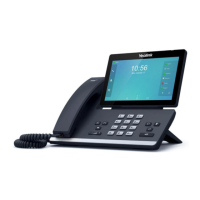Administrator’s Guide for SIP-T5 Series Smart Media Phones
676
3. Enter the new unlock PIN in the New PIN field.
4. Enter the new unlock PIN again in the Confirm PIN field.
5. Tap to accept the change.
To configure a phone lock key via phone user interface:
1. Tap Settings->Features->DSS Keys.
2. Tap the desired DSS key.
3. Tap the Type field.
4. Tap Key Event in the pop-up dialog box.
5. Tap the Key Type field.
6. Tap Phone Lock in the pop-up dialog box.
7. (Optional.) Enter the string that will appear on the touch screen in the Label field.
8. Tap to accept the change.
Transport Layer Security (TLS)
TLS is a commonly-used protocol for providing communications privacy and managing the
security of message transmission, allowing IP phones to communicate with other remote parties
and connect to the HTTPS URL for provisioning in a way that is designed to prevent
eavesdropping and tampering.
TLS protocol is composed of two layers: TLS Record Protocol and TLS Handshake Protocol. The
TLS Record Protocol completes the actual data transmission and ensures the integrity and
privacy of the data. The TLS Handshake Protocol allows the server and client to authenticate
each other and negotiate an encryption algorithm and cryptographic keys before data is
exchanged.
The TLS protocol uses asymmetric encryption for authentication of key exchange, symmetric
encryption for confidentiality, and message authentication codes for integrity.
Symmetric encryption: For symmetric encryption, the encryption key and the
corresponding decryption key can be told by each other. In most cases, the encryption key
is the same as the decryption key.
Asymmetric encryption: For asymmetric encryption, each user has a pair of cryptographic
keys – a public encryption key and a private decryption key. The information encrypted by
the public key can only be decrypted by the corresponding private key and vice versa.
Usually, the receiver keeps its private key. The public key is known by the sender, so the
sender sends the information encrypted by the known public key, and then the receiver
uses the private key to decrypt it.

